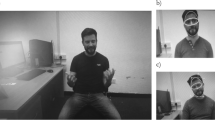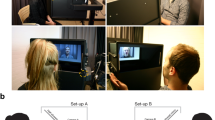Abstract
Few eye tracking studies have examined how people with autism spectrum disorder (ASD) visually attend during live interpersonal interaction, and none with the Chinese population. This study used an eye tracker to record the gaze behavior in 20 Chinese children with ASD and 23 children with typical development (TD) when they were engaged in a structured conversation. Results demonstrated that children with ASD looked significantly less at the interlocutor’s mouth and whole-face, and more at background. Additionally, gaze behavior was found to vary with the conversational topic. Given the great variability in eye tracking findings in existing literature, future explorations might consider investigating how fundamental factors (i.e., participant’s characteristics, tasks, and context) influence the gaze behavior in people with ASD.





Similar content being viewed by others
References
Alviar, C., Dale, R., Dewitt, A., & Kello, C. T. (2020). Multimodal coordination of sound and movement in music and speech. Discourse Processes: A Multidisciplinary Journal, 57, 1–21.
American Psychiatric Association. (2013). Diagnostic and statistical manual of mental disorders. (5th ed.). American Psychiatric Publishing.
Bates, D., Mächler, M., Bolker, B. M., & Walker, S. C. (2014). Fitting linear mixed-effects models using lme4. Journal of Statistical Software. https://doi.org/10.18637/jss.v067.i01.
Blais, C., Jack, R. E., Scheepers, C., Fiset, D., & Caldara, R. (2008). Culture shapes how we look at faces. PLoS ONE, 3(8), e3022. https://doi.org/10.1371/journal.pone.0003022.
Boraston, Z., & Blakemore, S.-J. (2007). The application of eye-tracking technology in the study of autism. The Journal of Physiology, 581(3), 893–898. https://doi.org/10.1113/jphysiol.2007.133587.
Caldara, R., Zhou, X., & Miellet, S. (2010). Putting culture under the ‘spotlight’ reveals universal information use for face recognition. PLoS ONE, 5(3), e9708. https://doi.org/10.1371/journal.pone.0009708.
Chita-Tegmark, M. (2016). Social attention in ASD: A review and meta-analysis of eye-tracking studies. Research in Developmental Disabilities, 48, 79–93. https://doi.org/10.1016/j.ridd.2015.10.011.
Czajkowski, M., Giergiczny, M., & Greene, W. H. (2014). Learning and fatigue effects revisited: Investigating the effects of accounting for unobservable preference and scale heterogeneity. Land Economics, 90(2), 324–351.
Doherty-Sneddon, G., Bruce, V., Bonner, L., Longbotham, S., & Doyle, C. (2002). Development of gaze aversion as disengagement from visual information. Developmental Psychology, 38(3), 438–445.
Falck-Ytter, T. (2015). Gaze performance during face-to-face communication: A live eye tracking study of typical children and children with autism. Research in Autism Spectrum Disorders, 17, 78–85. https://doi.org/10.1016/j.rasd.2015.06.007.
Falck-Ytter, T., Carlström, C., & Johansson, M. (2015). Eye contact modulates cognitive processing differently in children with autism. Child Development, 86(1), 37–47. https://doi.org/10.1111/cdev.12273.
Fletcher-Watson, S., Leekam, S. R., Benson, V., Frank, M. C., & Findlay, J. M. (2009). Eye-movements reveal attention to social information in autism spectrum disorder. Neuropsychologia, 47(1), 248–257. https://doi.org/10.1016/j.neuropsychologia.2008.07.016.
Frazier, T. W., Strauss, M., Klingemier, E. W., Zetzer, E. E., Hardan, A. Y., Eng, C., et al. (2017). A meta-analysis of gaze differences to social and nonsocial information between individuals with and without autism. Journal of the American Academy of Child and Adolescent Psychiatry, 56(7), 546–555. https://doi.org/10.1016/j.jaac.2017.05.005.
Freeth, M., Foulsham, T., & Kingstone, A. (2013). What affects social attention? Social presence, eye contact and autistic traits. PLoS ONE, 8(1), e53286. https://doi.org/10.1371/journal.pone.0053286.
Gibson, J. J. (1979). The ecological approach to visual perception. Houghton Mifflin.
Glenberg, A. M., Schroeder, J. L., & Robertson, D. A. (1998). Averting the gaze disengages the environment and facilitates remembering. Memory and cognition, 26(4), 651–658.
Grinter, E. J., Maybery, M. T., Beek, P. L. V., Pellicano, E., Badcock, J. C., & Badcock, D. R. (2009). Global visual processing and self-rated autistic-like traits. Journal of Autism and Developmental Disorders, 39(9), 1278–1290.
Hanley, M., McPhillips, M., Mulhern, G., & Riby, D. M. (2013). Spontaneous attention to faces in Asperger syndrome using ecologically valid static stimuli. Autism, 17(6), 754–761. https://doi.org/10.1177/1362361312456746.
Herlitz, M. (2018). Analyzing the Tobii Real-world-mapping tool and improving its workflow using Random Forests.
Hutchins, T. L., & Brien, A. (2016). Conversational topic moderates social attention in autism spectrum disorder: Talking about emotions is like driving in a snowstorm. Research in Autism Spectrum Disorders, 26, 99–110. https://doi.org/10.1016/j.rasd.2016.03.006.
Jacob, S., Wolff, J. J., Steinbach, M. S., Doyle, C. B., Kumar, V., & Elison, J. T. (2019). Neurodevelopmental heterogeneity and computational approaches for understanding autism. Translational Psychiatry, 9(1), 63. https://doi.org/10.1038/s41398-019-0390-0.
Jones, R. M., Southerland, A., Hamo, A., Carberry, C., Bridges, C., Nay, S., et al. (2017). Increased eye contact during conversation compared to play in children with autism. Journal of Autism and Developmental Disorders, 47(3), 607–614. https://doi.org/10.1007/s10803-016-2981-4.
Kanner, L. (1943). Autistic disturbances of affective contact. Nervous Child, 2, 217–250.
Kelly, D., Miellet, S., & Caldara, R. (2010). Culture shapes eye movements for visually homogeneous objects. Frontiers in Psychology. https://doi.org/10.3389/fpsyg.2010.00006.
Key, A. P. F., & Stone, W. L. (2012). Same but different: 9-month-old infants at average and high risk for autism look at the same facial features but process them using different brain mechanisms. Autism Research, 5(4), 253–266. https://doi.org/10.1002/aur.1231.
Klin, A., Jones, W., Schultz, R., Volkmar, F., & Cohen, D. (2002). Visual fixation patterns during viewing of naturalistic social situations as predictors of social competence in individuals with autism. Archives of General Psychiatry, 59(9), 809–816.
Klin, A., Lin, D. J., Gorrindo, P., Ramsay, G., & Jones, W. (2009). Two-year-olds with autism orient to non-social contingencies rather than biological motion. Nature, 459(7244), 257–261. https://doi.org/10.1038/nature07868.
Laidlaw, K. E. W., Foulsham, T., Kuhn, G., & Kingstone, A. (2011). Potential social interactions are important to social attention. Proceedings of the National Academy of Sciences of the United States of America, 108(14), 5548–5553.
Lenth, R. V. (2016). Lsmeans: Least-squares means. Journal of Statistical Software, 69, 1–33.
Lord, C., Risi, S., Lambrecht, L., Cook, E. H., Jr., Leventhal, B. L., DiLavore, P. C., et al. (2000). The autism diagnostic observation schedule-generic: A standard measure of social and communication deficits associated with the spectrum of autism. Journal of Autism and Developmental Disorders, 30(3), 205–223.
Lord, C., Rutter, M., & Le Couteur, A. (1994). Autism diagnostic interview-revised: A revised version of a diagnostic interview for caregivers of individuals with possible pervasive developmental disorders. Journal of Autism and Developmental Disorders, 24(5), 659–685. https://doi.org/10.1007/bf02172145.
Mastergeorge, A. M., Kahathuduwa, C., & Blume, J. (2020). Eye-tracking in infants and young children at risk for autism spectrum disorder: A systematic review of visual stimuli in experimental paradigms. Journal of Autism and Developmental Disorders. https://doi.org/10.1007/s10803-020-04731-w.
Melinger, A., & Levelt, W. J. M. (2005). Gesture and the communicative intention of the speaker. Gesture, 4(2), 119–141.
Mundy, P., Sigman, M., & Kasari, C. (1994). Joint attention, developmental level, and symptom presentation in autism. Development and Psychopathology, 6(03), 389–401.
Nadig, A., Lee, I., Singh, L., Bosshart, K., & Ozonoff, S. (2010). How does the topic of conversation affect verbal exchange and eye gaze? A comparison between typical development and high-functioning autism. Neuropsychologia, 48(9), 2730–2739. https://doi.org/10.1016/j.neuropsychologia.2010.05.020.
Norbury, C. F., Brock, J., Cragg, L., Einav, S., Griffiths, H., & Nation, K. (2010). Eye-movement patterns are associated with communicative competence in autistic spectrum disorders. Journal of Child Psychology and Psychiatry and Allied Disciplines, 50(7), 834–842.
Noris, B., Nadel, J., Barker, M., Hadjikhani, N., & Billard, A. (2012). Investigating gaze of children with ASD in naturalistic settings. PLoS ONE, 7(9), e44144. https://doi.org/10.1371/journal.pone.0044144.
Papagiannopoulou, E. A., Chitty, K. M., Hermens, D. F., Hickie, I. B., & Lagopoulos, J. (2014). A systematic review and meta-analysis of eye-tracking studies in children with autism spectrum disorders. Social Neuroscience, 9(6), 610–632. https://doi.org/10.1080/17470919.2014.934966.
Pierno, A. C., Mari, M., Glover, S., Georgiou, I., & Castiello, U. (2006). Failure to read motor intentions from gaze in children with autism. Neuropsychologia, 44(8), 1483–1488. https://doi.org/10.1016/j.neuropsychologia.2005.11.013.
Pönkänen, L. M., Alhoniemi, A. L., et al. (2011). Does it make a difference if I have an eye contact with you or with your picture? An ERP study. Social Cognitive & Affective Neuroscience, 6(4), 486–494.
Pouw, W., Trujillo, J. P., & Dixon, J. A. (2020). The quantification of gesture-speech synchrony: A tutorial and validation of multi-modal data acquisition using device-based and video-based motion tracking. Behavior Research Methods, 52, 723–740.
R core Team. (2013). R: A language and environment for statistical computing. R Foundation for Statistical Computing.
Ramseyer, F., & Tschacher, W. (2011). Nonverbal synchrony in psychotherapy: Coordinated body movement reflects relationship quality and outcome. Journal of Consulting and Clinical Psychology, 79(3), 284–295. https://doi.org/10.1037/a0023419.
Sasson, N. J., Pinkham, A. E., Weittenhiller, L. P., Faso, D. J., & Simpson, C. (2016). Context effects on facial affect recognition in schizophrenia and autism: Behavioral and eye-tracking evidence. Schizophrenia Bulletin, 42(3), 675–683. https://doi.org/10.1093/schbul/sbv176.
Spezio, M. L., Huang, P. Y., Castelli, F., & Adolphs, R. (2007). Amygdala damage impairs eye contact during conversations with real people. The Journal of Neuroscience, 27(15), 3994–3997. https://doi.org/10.1523/jneurosci.3789-06.2007.
Stevenson, C. E., Hickendorff, M., Resing, W. C. M., Heiser, W. J., & De Boeck, P. A. L. (2013). Explanatory item response modeling of children’s change on a dynamic test of analogical reasoning. Intelligence, 41(3), 157–168.
Thorup, E., Nystrom, P., Gredeback, G., Bolte, S., & Falck-Ytter, T. (2016). Altered gaze following during live interaction in infants at risk for autism: An eye tracking study. Molecular Autism, 7, 12. https://doi.org/10.1186/s13229-016-0069-9.
Thorup, E., Nyström, P., Gredebäck, G., Bölte, S., & Falck-Ytter, T. (2018). Reduced alternating gaze during social interaction in infancy is associated with elevated symptoms of autism in toddlerhood. Journal of Abnormal Child Psychology, 46, 1547–1561.
Wallace, S., Coleman, M., & Bailey, A. (2008). An investigation of basic facial expression recognition in autism spectrum disorders. Cognition and Emotion, 22(7), 1353–1380. https://doi.org/10.1080/02699930701782153.
Wan, G., Kong, X., Sun, B., Yu, S., Tu, Y., Park, J., et al. (2019). Applying eye tracking to identify autism spectrum disorder in children. Journal of Autism and Developmental Disorders, 49(1), 209–215. https://doi.org/10.1007/s10803-018-3690-y.
Wang, Q., Hoi, S. P., Wang, Y., Song, C., & Yi, L. (2020). Out of mind, out of sight? Investigating abnormal face scanning in autism spectrum disorder using gaze-contingent paradigm. Developmental Science, 23(1), e12856.
Wang, Q., Hu, Y., Shi, D., Zhang, Y., Zou, X., Li, S., et al. (2018). Children with autism spectrum disorder prefer looking at repetitive movements in a preferential looking paradigm. Journal of Autism and Developmental Disorders, 48(8), 2821–2831. https://doi.org/10.1007/s10803-018-3546-5.
Westfall, J., Kenny, D. A., & Judd, C. M. (2014). Statistical power and optimal design in experiments in which samples of participants respond to samples of stimuli. Journal of Experimental Psychology General, 143(5), 2020–2045.
Yi, L., Feng, C., Quinn, P. C., Ding, H., Li, J., Liu, Y., et al. (2014). Do individuals with and without autism spectrum disorder scan faces differently? A new multi-method look at an existing controversy. Autism Research, 7(1), 72–83. https://doi.org/10.1002/aur.1340.
Yi, P., Quinn, C., Feng, K., et al. (2015). Do individuals with autism spectrum disorder process own- and other-race faces differently? Journal of Vision, 15(12), 649–649.
Funding
The study was financially supported by the SZU funding project (No. 860-000002110259), the Science and Technology Innovation Committee of Shenzhen (No. JCYJ20190808115205498), Sanming project of medicine in Shenzhen (No. SZSM201612079), Key Realm R&D Program of Guangdong Province (No. 2019B030335001), Shenzhen Key Medical Discipline Construction Fund (No.SZXK042), and Shenzhen Double Chain Grant [2018]256.
Author information
Authors and Affiliations
Contributions
Zhong Zhao, Xiaobin Zhang, Xingda Qu and Jianping Lu involved in the experimental design and the recruitment of participants. Zhong Zhao, Haiming Tang, Zhipeng Zhu, Jiayi Xing, Wenzhou Li, Da Tao analyzed data and performed the statistics. Zhong Zhao, Haiming Tang, Xiaobin Zhang and Xingda Qu drafted and revised the manuscript.
Corresponding author
Additional information
Publisher's Note
Springer Nature remains neutral with regard to jurisdictional claims in published maps and institutional affiliations.
Appendix
Appendix
Details of the Four Sessions of the Structured Conversation
General questions |
1. What is your name |
2. How is your name written |
3. What is the name of your school and what grade are you in? |
4. Who is your best friend? What is your favorite thing to do together? |
5. Could you please share with me the most interesting thing happened last week? Let me know the time, place, people and the whole process of the event |
6. What is the plan for your summer vacation? |
Interest topic |
1. What is your favorite thing to do? And could you tell me why you like doing it? |
Yes–no questions |
1. Do you like apples? |
2. Do you like to go to the zoo? |
3. Do you like to go to school? |
4. Do you like reading? |
5. Do you like painting? |
6. Do you like watching cartons? |
7. Do you like sports? |
8. Do you like watching movies? |
9. Do you like traveling? |
10. Do you like shopping? |
Question-raising |
1. Now I have asked you many questions, do you have any questions for me? |
Rights and permissions
About this article
Cite this article
Zhao, Z., Tang, H., Zhang, X. et al. Characteristics of Visual Fixation in Chinese Children with Autism During Face-to-Face Conversations. J Autism Dev Disord 53, 746–758 (2023). https://doi.org/10.1007/s10803-021-04985-y
Accepted:
Published:
Issue Date:
DOI: https://doi.org/10.1007/s10803-021-04985-y




